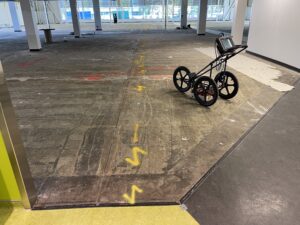
How far can GPR go into the ground?
It all depends on the kind of application you want to do with it. If you want to use it for concrete scanning, it is about 10 feet into the ground. For areas with clay and grass, it is only a few feet. Finally, for sandy soils, the GPR can go down to 30 feet underground. Of course, it all depends on the site conditions and if need be a larger antenna is used to allow better penetration.
Can you trust the accuracy of the GPR results?
The accuracy always depends on how difficult your target is. If you want to use the technology to detect buried cables, pipelines, landmines etc., the detection can be very precise (around 90%). If you want to detect cracks, damaged zones etc., the GPR technology is the best you’ll ever have. For environmental applications such as finding oil leaks from tanks, polluted zones etc., the GPR is a success. In conclusion, if the GPR is used judiciously and within its application limits, you can have great accuracy with less than a 10% error margin.
Can The GPR detect the exact size of a subsurface void cavity?
The GPR sends a radio pulse down into the ground, and when it detects an anomaly in the soil, a reflected signal is sent to the receiver. The process is quick, accurate and inexpensive, and allows the contractor to effectively complete the repair process. It is also very easy for the GPR to detect the void’s boundaries as well as its depth.
Can a GPR distinguish each type of located underground utility?
Ground penetrating radar and other tools are used to locate and identify underground utilities. Most of the time, it is very easy to detect the nature of the utility in question without any problems. However, when it is not possible to identify the exact type of utility, it is necessary to use the GPR to detect something else like a valve, a control box, or cable in order to determine with exactitude its nature. With the GPR, you can safely and successfully locate and identify buried utilities without damaging the ground or the environment.
What are the GPR’s limitations?
The GPR is very effective, however it does have limitations. The radar’s effectiveness is site specific and varies greatly from place-to-place: the concrete ground, soil conditions and the weather, are just a few of the existing limiting factors. So far, the most significant GPR performance limitation has been in highly conductive materials like clay soils and contaminated soils.
Also, the performance is also limited by scattered signals in heterogeneous conditions (ex: rocky soils). The changes in soil type like density and water content also play their part in the limitation because the antenna can’t penetrate correctly, which misleads the detection. Also buried objects are a problem because it can be difficult to identify the desired target (ex: it is impossible to find the individual tree in a forest). And finally, the GPR can’t see through metal plates, fine metal mesh and or pan decking. In that case, it is necessary to use the detection as close as possible to the site to see what is underneath.
What is the informational output provided when utilities are found?
The best survey output is to mark it off with paint directly on the surface of all the things found underground. To date, this is the most accurate form of marking. It is also the best if you want to start the excavation a few days later. Also, the GPR uses GPS technology to gather all the findings data points.
In fact this data is really important because it can be used to create a plan with Google Earth, or with CAD files. Ultimately, it can help preserve findings for all the future uses. It is important to remember that the GPR can’t do land surveying. If you need land surveying services, you have to contact a professional land surveyor.
Is the GPR effective to scan CMU walls?
Yes it can. The GPR equipment is very effective to do concrete scanning and it can be used on concrete floors as well as concrete masonry unit (CMU) walls. For the CMU, the GPR can help you find out if there are grouts and vertical rebars within the structure.
Is it possible to use the GPR on vertical surfaces and ceilings?
Yes it is possible. In fact, the GPR is regularly used to scan concrete columns and walls to search for rebars. Recently, they have been used on infrastructures like bridges and viaducts that are in bad conditions and need reparation or restoration. With the GPR, the workers avoid accidents and collapses. As for the ceiling, the GPR can detect its reinforcing steel and the embedded conduits before any construction work.
